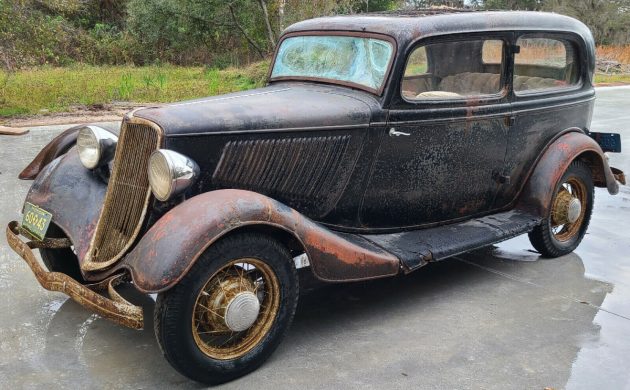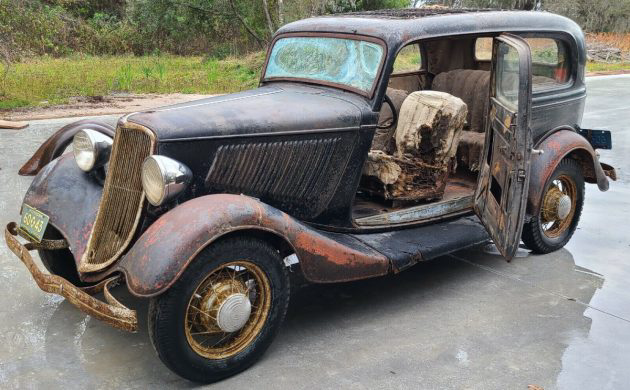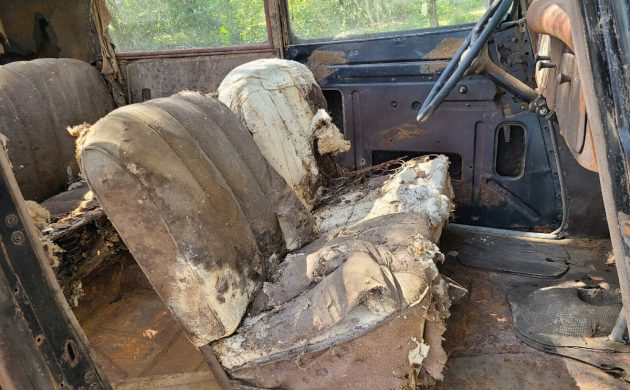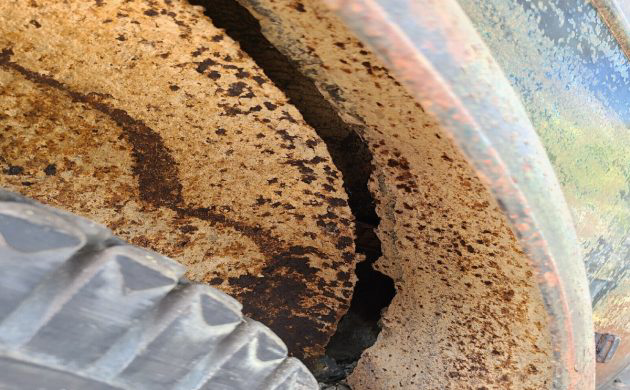The seller claims this 1933 Ford Vicky is a real-deal barn find and has survived virtually untouched for almost 90 years! It can be found here on eBay with a requested opening bid of $13,500. There have been no bids yet, but this car looks like a great project to me. Located in Sarasota, Florida, the ad says that they have only owned the car for about a year and there is no other history mentioned other than it being “an all original steel Henry Ford body.” Check out this suicide-door sedan.
Factory suicide doors are really cool. Some people spend countless hours converting a “traditional door” vehicle into a suicide door custom. Several changes were made during the 1933 model year including the sloped grille.
There are several photos of the interior of the car, but none of the engine compartment. The seller says the engine and transmission are missing for an unknown reason. Perhaps it wasn’t running well, which caused the owner to park it for several decades?
There are a couple of photos of some rust on the inner fender wells. The ad says that besides those areas, the “floors, doors, door jambs, etc are solid as rest of body. Doors open, close, and line-up perfectly.” The seller is including an extra set of rear fenders, but if this was my car, I would leave it as-is. How about you?






Very rare as the great depression was raging. Without the original engine, transmission etc. this is no more than a parts car. Rare does not always equate to valuable.
You obviously know nothing about the early Ford market.
You can get every part for these, the body and chassis is solid and complete, and as for the engine, you can easily find a Flathead for it or turn it into a street rod.
This car will easily sell for at least twice the opening bid.
So true Steve. This is an excellent starting point on a rare pre war Ford. A hopped up 239 flatty isn’t a problem.
You’re just joking! Right? I mean, inner fenders and many other CRITICAL areas completely rusted through in anything but a “solid” vehicle. Doubtful it would hold together for transporting.
Nothing but a rusting hulk. Less than a year ago, here in central Texas, a completely restored identical car sold for less than $12,000. I mean, just off the showroom appearance turn-key running. The only drawback was the bright canary yellow color – although it was perfectly painted.
IF you saw one sale for 12 K restored, it would’ve had to been a fiberglass car, and even then that would have been about half of what it was worth. Real Steel Fords are bringing big money, in any condition. This one should sell easliy.
Sorry to say but this is not a Vicky. It’s a Tudor sedan.
Hate to rain on someone’s parade but that doesn’t look like a Victoria. The Vicky has a ‘Bustleback.’ I think it was ’35 before Ford started building the ‘Humpback.’ I’m thinking this was a B-model, with the 4-Banger. There would be some indication on the grill that it sported a V8 otherwise. Definitely a ’33 because of the curved grill and hood louvers. A ’33 would only have a single latch on the hood as well. Either way I sure wouldn’t kick it off of my driveway. Sure needs a lot of work but other than missing an engine or transmission, it looks like the rest of it is there…
It is a ’33, but not a Vicky. It’s a Tudor.
Seller says it’s not a vicky, on ebay, but people sometimes call it that. So they do know that it isn’t one. Must be trying to prey on those, not in the know. False advertise much?
Has this vehicle been sold?
What is there to “match numbers” to on a vehicle without a powertrain? If the chassis is good enough I’d love to take something like this, put in a very mild modern powertrain, and just putter around in it.
Thing is: to match numbers on a Ford the only real accurate thing would be the VIN stamped on the transmission, not the engine. Since Ford was into an engine rebuilding program very few original engines made it through, and it was unlikely that you would be able to identify an engine as original because there usually wasn’t much to go on…
I agree! Other than doing something with that God-awful interior and putting in a working, period-correct engine and transmission, as well as other, safety-related necessities, I would leave the exterior as-is, and it would get a lot of attention a the local cruise night.
It’s a 1933 Tudor
You obviously know nothing about the early Ford market.
You can get every part for these, the body and chassis is solid and complete, and as for the engine, you can easily find a Flathead for it or turn it into a street rod.
This car will easily sell for at least twice the opening bid.
I could be wrong but that doesn’t appear to be a Victoria, rather a 2 door sedan. Anyone have picture to prove me wrong?
This car would make a great resto rod. But I would also put a Ford engine back in it. Ford – Ford, not Ford – Chevy. It’s not a Vicky but a Tudor sedan. Great find.
If you read the text in the listing, the seller states “it’s not a Vickie, but most people don’t know the difference”. Would be nice to see the whole right side in a photo. Very rare, never see these original, wish I was younger and richer!
They say confusion is the first step to learning something so I’m confused enough here to learn a LOT! Wasn’t this the era of the popular Ford Model A’s? And the B’s were upscale? So can I assume a Vicky was an A or a B? And, since the seller says this car WASN’T a Victoria, what was it? Was it just a two-door Ford? If you bought it new and drove it home, would you tell the neighbors “hey look – I bought a two-door Ford!”?
Model A was only produced from 1928 to ’31.
Geomech has it right. This is a 4-holer ’33 low-buck Tudor. Note the single tail light. Edsel Ford had a strong hand in design here, but the ’33s also had serious design flaws; the grilles were too slender and delicate, and the curved louvers were a production nightmare, the single hood latch allowed for a lot of ‘flop’, and the front door design got a window stiffener at the rear (hinge-side) edge. Didn’t this year also see the intro of the Model ‘C’ 4-banger as well?
This is a 1933 Tudor 2 door sedan, not a Vicky, no confusion, completely different body style, and going by all the hubcaps which have Ford on then and not a V8 sign, this car is a 4 cylinder model, not a V8 engine car.
Styling was perfection in that era of time.
This old gent was born the same year that Henry produced his survivor. If some one out there that would make a gift of the ’33 to me along with all its’ faults, I would forever be grateful. An old phartt gearhead.
Bonnie & Clyde blew the engine back in the day & the owner let it sit & charged a nickel for people to see it…
Agree with most of the above but If I was going to start the massive effort of restoring it the first thing I’d do is replace the rusty rear fenders.
“This car will easily sell for twice the opening bid.” For reasons which defy comprehension. Kind of small, not that great a design, lots around like it, interior is worse shape than the dumpster behind the grocery store. I like old cars, but the ride and panache of the Cadillac here is vastly superior IMO and to me, anyway, worth more $.
Not that it matters, the “B” serial number shown, also confirms that it was a 4-cylinder car…
Looks to be an honest car – it will most likely go across the pond to somebody in Europe. Like Steve had mentioned – not a lot of people know the early Fords pricing.
Steve S, I may know little about the early Ford market. You act like an expert. You state it will sell for twice the opening bid. Just checked the auction and there still is no opening bid !!
Give it time.
Sonce she already has not engine or trans I would love to do a flatty V8 and manual along with some updated brakes. Inner wheel wells too of course. Good find.
Geomechs, you get some things right, but you also get some wrong. For example model B was only in 32 and the B designated it was a 4 cylinder, otherwise it was a V-8. In 1933 and 1934 they were all V-8’s ,there was a C model which was a 4 cylinder and it was in trucks. I am not absolutely positive ,but I have never seen a 4 cylinder in a car and I have seen allot of 33 and 34’s , and I have owned my 34 coupe for almost 60 years. There is no doubt Henry was, a little inconsistent and over the years lots of things have been said and done ,and stories repeated, so I am not sure everything is all that factual, even those of us that were around, are not entirely sure ,and the people I am referring to like myself are over 75 years old.
Hi Joe. I heard that the B engine was so-named because it had full-pressure lube, a mechanical fuel pump and a centrifugal advance. I also heard of the B reference carrying on until Ford discontinued it in ‘34. I also heard references to a C engine which was used in ‘33 and ‘34 which was the B engine with counterweights. Technically I think you’re right in that the proper term for ‘33 and ‘34 was the C. However I do know that cars were available with the 4-homer in ‘33. I know of (2), sedans, just like this one. The car club I belong to donated the interior to one that is being restored by the Reynolds Museum, and will be one of their drivers…
Will someone please turn out the lights so Rusty can get some sleep??
Will someone please turn out the lights so Rusty can get some sleep?
Even though it is a pile of Florida rust, it is far better looking than any junk coming from Ford, or any other car maker today. I work at a Chrysler, Jeep and Dodge dealer. These cars break down all day long. Problems, problems, problems and $50,000 for a Jeep that falls apart in 4 years. I have worked in the auto industry almost 50 years. The electronics have ruined cars and the ridiculously thin oils, now 0W40, etc, cause, what I believe premature engine wear. Today’s Hemis eat camshafts and related parts. Also, the vast array of metals used in making today’s junk engines causes untold problems not seen years ago. One example is broken exhaust manifold studs. While I am not into 30s Fords, the market is incredibly strong and yes, this will sell, but I doubt twice the opening bid.
I don’t care what it “is”. I would make it structurally and mechanically sound and drive the hell out of it. :)